“Then they removed her gallbladder, placed it in a container of wine and drank it” – witness describes execution
Mr. Sean Sung continued his testimony today, October 28, and answered questions related to the massacre that he said to have seen in 1978. He told the court that he watched 60 to 80 people being killed by the Khmer Rouge, amongst them children. The soldiers who killed the victims were, according to this testimony, between 14 and 16 years old with one adult leading the group. One of the persons who were killed, Chantha, was a woman of Vietnamese descent. Mr. Sung recounted that the soldiers tied her legs behind her back, cut open her body, took her gallbladder and put it in a container filled with wine that the soldiers drank.
There will be no court session until the Supreme Court hearings start on November 16. Trial Chamber hearings start again on November 30.
Execution of Woman of Vietnamese Descent
At the beginning of the first session, the Trial Chamber Greffier confirmed the presence of all parties, with Nuon Chea following the proceedings from the holding cell. The floor was then granted to the Co-Prosecutors.
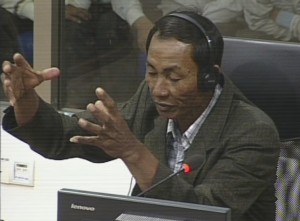
Witness Sean Sung
Mr. de Wilde started his line of questioning by turning back to the topic of executions and asked whether Mr. Sung heard the soldiers insulting or humiliating the victims, which the witness denied. All victims were thrown into a pit. Mr. de Wilde then asked about the execution of Chantha, the Vietnamese woman who was a member of his mobile unit. Mr. Sung recounted that he heard them mentioning her name when they walked her away. He saw them walk toward the pit. However, she was not killed there.
She was dragged away about ten meters from the pit. And then they actually bent her head down under her legs. Then they removed her gallbladder, placed it in a container of wine and drank it. (…) She was left there. Then they continued killing the people who were brought out from the pagoda.
Mr. Sung stated that he only witnessed such an incident once. Mr. de Wilde inquired whether Mr. Sung knew why they removed her gallbladder and put it in alcohol, which Mr. Sung could not answer.
Mr. de Wilde then inquired whether Mr. Sung knew that Chantha was Vietnamese when he was walking in the same mobile unit as her, which Mr. Sung confirmed. Mr. de Wilde then wanted to know whether it was commonly known that the family was Vietnamese, which Mr. Sung confirmed. The means to distinguish her from Khmer people included the way she walked and the facial figures. In the village, there were only her and her grandparents. Everyone, to Mr. Sung’s knowledge, knew that she was Vietnamese. She was the only one who was taken to Ksach pagoda.
Number of Victims
Mr. de Wilde then asked how many Vietnamese people Mr. Sung saw being executed during the hour he stayed there. Mr. Koppe objected on the basis that Mr. Sung did not know whether the people who were killed were Vietnamese. He was also in no position to know this, since he was not present at the arrest, did not participate in any way and also did not know about any lists.
Mr. de Wilde responded that three witnesses had said that Vietnamese beforehand. Moreover, the witness had testified yesterday that the victims were all asked whether they were Vietnamese or Chinese, and those who answered they were Chinese were spared. Mr. Koppe argued that this was not sufficient to establish whether all victims were Chinese, since Mr. Sung’s friend, who also attended the execution, did not hear these questions. The objection was sustained.
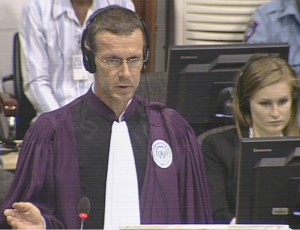
Senior Assistant Prosecutor Vincent de Wilde
Mr. de Wilde inquired whether Mr. Sung could give an estimate of the number of people who were killed during the hour that he watched them. Mr. Sung replied that he saw around 50 to 60 people being killed. Mr. de Wilde then referred to the witness’s first interview, in which he had stated that he saw 70 to 80 people being killed, and compared it to the witness’s second interview: in this interview, he had indicated a number of more than 100 people being executed by twelve Khmer Rouges.[1] Mr. de Wilde asked Mr. Sung to clarify the number. Mr. Koppe commented that the same Written Record of Interview also said that 500 to 600 people were killed. His friend had stated that around 25 people were being killed. Mr. de Wilde responded that the number of 600, not 500, referred to the number of total victims, and not the one that Mr. Sung witnessed being killed.
Mr. de Wilde then repeated his question. Mr. Sung replied that the number could be between 60 and 80. “Of course I did not count”, so he could only provide an estimate. When he left, the executions continued.
Mr. de Wilde then referred to the witness’s interview, during which he had talked about the transport of Vietnamese with oxcarts to the pagoda. He remembered this clearly, according to the interview, because he was staying close to Wat Ksach with his mobile unit.[2] Mr. de Wilde asked how Mr. Sung knew this. Mr. Sung replied that people in the village told him so.
Mr. de Wilde then asked whether Mr. Sung could estimate how many people were detained temporarily in the library hall in the pagoda before being executed. Mr. Sung estimated that there were 300 to 400 people in the library hall of the pagoda. He estimated this number, because he heard voices in the library hall.
Mr. de Wilde further asked what the dimensions of the pit were where the victims were thrown into. Mr. Sung replied that it was five meters by five meters with a depth of three meters. He came back to the pagoda once. However, he did not dare to stay long. He looked at the outside of the compound and entered the compound of the pagoda. He saw that “the dirt was used to partly cover the pit”. On that night that he went to the pagoda, he only saw one pit. When he came back to the pagoda, he saw a well in the pagoda that was also a pit, and another pit near the pagoda that was considered an “old pit”. He could see what was inside the pit, since it had not been covered yet.
Mr. de Wilde inquired whether Mr. Sung saw bodies in the well or the other pits. Mr. Sung replied that there was water in the well, and the bodies were “floating five or six meters away from that well.”
Referring to the witness’s interview, Mr. de Wilde asked how long Mr. Sung had actually been watching the executions: in the first interview, he had said that he watched a little more than an hour, while he mentioned having watched three hours in his second interview.[3]
Mr. de Wilde asked how he was able to measure the time that went by and how much time he spent there. Mr. Sung replied that he might not have recalled well how much time he spent there, but “what I said was right.”
According to Mr. Sung, the investigators had asked him to show the pits. The investigators also asked other villagers to corroborate his statement. There was one monk who was not sure what happened during that time. He could not remember whether any photos were shown to him.
Mr. de Wilde then requested leave to present photographs to the witness.[4] The first showed a place where 160 people were executed. The second showed him at observation station. The third showed the observation station and the fourthdepicted the location where he found 50 more dead people. Mr. Sung confirmed that it was him on the photos. With this, Mr. de Wilde finished his line of questioning and gave the floor to the Civil Party Lead Co-Lawyers.
Civil Party Co-Lawyer Hong Kim Suon from the Cambodia Defenders’ Project started his line of questioning by turning back to the killing of the Vietnamese woman Chantha. Mr. Kim Suon inquired whether it was true that they bound her feet to her head, which the witness confirmed. “They did not undress her at the time.” He then asked whether Mr. Sung knew how Chantha’s parents died, which the witness could not answer.
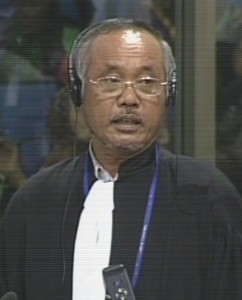
Civil Party Co-Lawyer Hong Kim Suon
Mr. Kim Suon then inquired whether the children were killed in the same way as the parents. Mr. Sung recounted that “sometimes, when the children arrived at the place, they were hit with the bamboo sticks.” Some other children were thrown in the air and fell into the pits. Mr. Sung denied that the children’s bowels were opened when they were killed. Mr. Sung said that female victims were not raped when being killed. Those who were brought to be killed were put far away from each other. The witness did not know whether the family members could witness the executions of their relatives.
Mr. Kim Suon then referred to Mr. Sung’s interview, in which the witness had stated that a village chief named Soy had stated that he received orders from his superiors to kill the Vietnamese.[5] When Mr. Kim Suon asked whether he heard this directly from the village chief and whether this village chief received direct order, Mr. Koppe objected, stating that this was a leading question. The objection was upheld.
Mr. Kim Suon referred to another document instead[6] and asked whether Mr. Sung knew about the killing of the Vietnamese from one village chief, and if yes, what his name was. Mr. Sung replied that the village chief’s name was Soy. This village chief had told him about the killing of Vietnamese people. Mr. Sung could not recall what exactly Soy had told him.
Mr. Kim Suon then stated that Mr. Sung had stated in one of his interviews that the village chief received orders from his superiors.[7] At this point, Mr. Koppe objected again and stated that the line of questioning had to move “step by step”. He considered the line of questioning as inappropriate. The President instructed the Civil Party lawyer to rephrase his question.
Mr. Kim Suon asked whether Mr. Sung still stood his statement that the village chief received orders from his superiors, which Mr. Sung confirmed.
At this point, the President Nil Nonn adjourned the hearing for a break.
Back to the Execution of Chantha
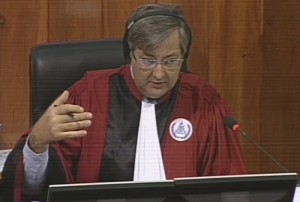
Judge Jean-Marc Lavergne
After the break the floor was given to Judge Jean-Marc Lavergne. Judge Lavergne asked whether he heard any statements being made on the treatment of the Vietnamese from the cadres in the village that he worked in, which Mr. Sung denied. Judge Lavergne then asked whether the pagoda building that presently exists was the same as when Mr. Sung witnessed the executions, to which Mr. Sung replied that some changes had been made. “No, it was not the same, since there had been some changes.” The dimensions are the same. “However, the monks have built other halls and planted some trees.” Mr. Koppe interjected and stated that he would appreciate it if Judge Lavergne used the term “alleged executions” and not simply executions. Judge Lavergne replied that he was referring to what the witness had testified on and therefore did not see the need to use the word alleged. He then repeated his question of whether the dimensions of the library hall were also the same, which Mr. Sung confirmed. It had been refurnished, but the dimensions remained the same. All people were detained in the library. There were no soldiers stationed in the pagoda. The fence to the national road was made out of concrete, while some other parts were made out of bamboo. Since he has not been to the pagoda again, he does not know whether the fence is still the same. When he saw the executions, he was outside of the compound of the pagoda. “I saw it happen outside the compound.”
Judge Lavergne asked whether he was sure that he removed Chantha’s gallbladder or another organ, seeing that he was 30 or 40 meters away. Mr. Sung replied that he saw that she was tortured. There was a Buddhist tree close to the scene. The organ that was as big as the size of his two fingers could be clearly seen. After having removed the gallbladder, they stirred it with a bamboo stick in alcohol, which was also used to kill victims. He had never heard of such a practice before. There was one adult at the time who was as tall as Mr. Sung at the time. Other soldiers were younger. When they carried the guns they dragged it over the floor. To his estimate, they were around 14, 15 or 16 years old. They were adolescents. The weapons were AK rifles. The soldiers were too small to carry those rifles.
Adolescent Soldiers
Nuon Chea Defense Counsel took the floor and started his line of questioning by asking whether all of the soldiers were carrying AK rifles. Mr. Sung confirmed this. “They were all armed.” Mr. Koppe asked whether it was correct that they used bamboo sticks instead of killing them with their rifles, which Mr. Sung confirmed. Mr. Koppe then inquired whether it was correct that Mr. Sung was around 18 or 19 years old at the time, which Mr. Sung confirmed. Mr. Koppe asked whether it was therefore correct that Mr. Sung was around 15 years old when the Khmer Rouge took power. Mr. Sung replied that he could not recall it well.
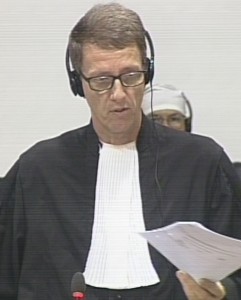
International Nuon Chea Defense Counsel Victor Koppe
Mr. Koppe asked whether Mr. Sung went to school before April 1975 and if yes, how long Mr. Sung went to school for. Mr. Sung answered that he went to school, but only finished low grades. He could not recall the number of years. He started school when he was eight years old. He could not recall what year that was. Mr. Koppe asked whether it could be 1968, or another year, to which Mr. Sung replied “I do not dare to answer it”. Mr. Sung stated that he could read and write only very little. He did not know the age of Chantha. She was perhaps a “little bit older or younger” than the witness, judging from her appearance. He did not know
whether it was a Vietnamese or a Khmer name. Mr. Koppe then inquired whether Mr. Sung ever saw some kind of ID or a document with her name of it at some point, which Mr. Sung denied. He never heard villagers speak about her parents.
When Mr. Koppe asked whether he “knew for certain” that Chantha was Vietnamese, since she was born in the witness’s village and spoke Khmer without an accent, Mr. de Wilde objected and stated that the witness had not said that she was born in his village. Mr. Koppe rephrased his question and asked how Mr. Sung knew for certain that Chantha was Vietnamese. Mr. Sung replied that villagers said that she was of Vietnamese descent.
Mr. Sung could not answer whether Vietnam and Kampuchea existed at the time that Chantha’s grandparents were born. When Mr. Koppe asked whether Mr. Sung had ever heard of Indochina, Mr. Sung replied that he had heard of it when he was young, but did not know what it meant.
Mr. Koppe asked whether it was correct that Mr. Sung only knew Chantha amongst the victims. Mr. Sung replied that he only knew one of the victims and did not know the others. He did not know why the young soldiers executed the people. Mr. Koppe asked whether “such things” were done from soldiers to other soldiers “in order to receive the strength” of the opponent. Mr. Sung replied that he had never heard of it.
Mr. Koppe asked whether Mr. Sung knew why only Chantha became victim of “this act”, which Mr. Sung could not answer.
Mr. Koppe asked whether Mr. Sung had an explanation why the soldiers asked the victims whether they were Vietnamese or Chinese while they knew Chantha. Mr. Sung said that he did not know. Mr. Koppe then asked whether Mr. Sung knew the reason for their asking whether the victims were Chinese or Vietnamese, if they had rounded up the Vietnamese already. Mr. Sung could not answer this question. When Mr. Koppe asked whether it was the perception at the time that Chinese people looked like Vietnamese, Mr. Sung replied that he witnessed the scene at night time. Mr. Koppe then asked whether the friend who also witnessed the executions also heard the question whether they were Chinese or Vietnamese, which Mr. Sung could not recall. Mr. Koppe then inquired whether it was correct that two Chinese families were not killed when they answered that they were Chinese, which Mr. Sung confirmed. He never heard any stories about these families afterwards. He recounted that they sent the Chinese people back to the pagoda compound when they said that they were Chinese. Mr. Koppe then asked whether the other people saw the Chinese people being taken away, to which Mr. Sung answered that “they postponed the execution”. They first took the Chinese people to the pagoda, after which they started the executions. He confirmed that his friend witnessed this as well.
When Mr. Koppe asked whether Mr. Sung knew why his friend did not testify about this part of the execution, Mr. de Wilde seems to have stood up on his feet, since Mr. Koppe withdrew his question.
Mr. Koppe asked whether he heard the question “are all of you Yuon”, which Mr. Sung confirmed. Mr. Sung could not see the Chinese families clearly. The soldiers did not verify whether the people who said they were Chinese really were Chinese. Mr. Sung did not know whether this meant that anyone who said that they were Chinese would not be killed, which Mr. Sung did not know. Neither did he know the people who killed Chantha. There was one man who was older than “my current age” amongst the group. The people in the group who killed Chantha were around 14 or 15 years old. The soldiers were wearing black shirts, pants and a cap. He did not know whether the soldiers belonged to the commune, district or center. Neither did he know that there was a lot of fighting shortly before the Vietnamese arrived.
He did not see these soldiers in the presence of Soy.
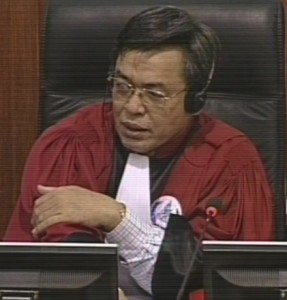
Trial Chamber President Nil Nonn
Mr. Koppe asked whether Mr. Sung had slept in the pagoda while working in the mobile unit, which Mr. Sung confirmed. His mobile unit stayed in there, but he could not recall how long. However, they did not stay inside the compound for long, but moved to the outside. He and is mobile unit members had already left the
pagoda when the executions took place. They were sleeping 200 meters to the North of the pagoda. He could not remember how long they had been sleeping there when the executions took place. Mr. Sung did not know whether the soldiers had moved into the pagoda already at the time that the execution took place.
Mr. Koppe asked whether it was coincidence that Mr. Sung happened to have the night off to visit his family when Chantha was killed, which Mr. Sung confirmed. He did not know the executions would take place. He sought permission to visit his family that day, which was granted. The person who accompanied him was his best friend, so “wherever I went he went as well”.
At this point, the President adjourned the hearing for a break.
On the way to his family
After the lunch break, the floor was given back to the Nuon Chea Defense Team. Mr. Koppe resumed his line of questioning by turning back to the execution of Chantha. Mr. Koppe asked whether it was correct that a woman told the people in her mobile unit that Chantha was being transferred to Phnom Penh to be trained in tailoring or sewing, which Mr. Sung confirmed. Santha herself had said so. The day before her execution, she had said that she would go to Phnom Penh to study. He did not know what happened to her grandparents, but they were called Ta Kouh and Yeay Hey.
This prompted Mr. Koppe to refer to another witness’s statement.[8] This witness had said that the grandparents were killed one day before the Vietnamese came. Mr. Koppe asked whether Mr. Sung had ever heard this himself. Mr. Sung said that he had heard so from others. Mr. Koppe asked who gave him the permission to visit his family that day. Mr. Sung replied that “we the youths” told each other that they could visit their families. However, Mr. Sung confirmed the next question, namely that he received special permission. Asked who gave him this permission, Mr. Sung replied that the request was submitted to the youths of the unit. He went back home in the dark, because that was the time when he finished work. He could not remember the name of the chief of the youth unit who granted his request. Mr. Sung confirmed that his friend filed the same request the same day.
Mr. Koppe asked whether it was correct that Mr. Sung had said yesterday that he invited his friend for a walk when he was suspicious. Mr. Sung replied that he could not recall.
Mr. Koppe asked whether it was correct that Mr. Sung’s friend was an adult and that he could “see things” because of this. Asked about the age of his friend, Mr. Sung replied that he was over sixty years old. Mr. Koppe said that the Written Record of Interview of this friend indicated that this friend was only two years older than Mr. Sung. Mr. Sung insisted that he did not know the age of his friend, but that he thought his friend had been around 60 years old. When Mr. Koppe repeated his question, Mr. Sung said that judging by his physical appearance he might have been 30 years old. “He looked very old in terms of his physical appearance and his face.”
Judge Claudia Fenz interjected and stated that the interpreter had told her that the age of 60 years old Mr. Sung was referring to was the age his friend would have now. Mr. Koppe asked again about the age of his friend, to which Mr. Sung answered that he would have estimated his friend to be almost 30 years old at the time.
Mr. Koppe then referred to another witness’s statement, who had said that “they forbid the people from walking nearby”[9] Mr. Sung replied that he had not heard of this. Mr. Koppe turned to another topic and asked whether it was correct that there was no stupa at the pagoda nowadays. Mr. Sung replied that he did not know. When Mr. Koppe asked whether Mr. Sung had an explanation for the fact that there was no official killing site identified by DC-Cam, Mr. de Wilde objected and said that this question would lead to a speculative answer. Mr. Koppe asked whether Mr. Sung attended a ceremony during which the remains of the alleged victims could be seen, to which Mr. de Wilde objected: it would have to be clarified where Mr. Sung lived first. Mr. Koppe then asked whether Mr. Sung had ever heard about such a ceremony. Mr. Sung replied that when the Vietnamese arrived in the country, he moved to Svay Khleang.
Turning to his last question, Mr. Koppe asked whether it was true that Mr. Sung had actually never witnessed any execution but heard so only from the village chief. Mr. Sung replied that it was not true and that he saw the execution at the site.
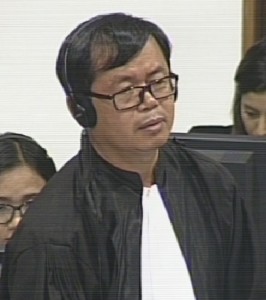
National Khieu Samphan Defense Counsel Kong Sam Onn
Khieu Samphan Defense Counsel Kong Sam Onn inquired about Mr. Sung’s mobile unit. Mr. Sung said that they had to build dams and dykes. He could not recall what the tasks were at the time of the execution. Neither could he remember the name of the mobile unit chief. They would sleep at a sleeping quarter when returning from harvesting rice, for example. The work site would sometimes be around one or two kilometers away from the sleeping quarter and sometimes 500 meters. The other people of his mobile unit “were resting” while he went to his village. He was heading to Cheang Village. They first had to head to the east before turning to the south to reach his house. There were two roads: one from the national road to the entrance of the pagoda. There was another road that led away from the pagoda to the east of the pagoda. The entrance is from the side of the national road. To walk home he took a shortcut through the rice fields. He arrived at his house that night. His aunts and uncles were there. His uncle was Choan and Koeun was his aunt. She passed away a long time ago. His uncle is still alive today. He did not tell them about the event. When Mr. Sam Onn asked whether Mr. Sung remembered why he had not told his uncle and aunt about the event Mr. de Wilde interjected and said that it had not been established whether Mr. Sung went to his uncle’s place before or after the execution. Mr. Sam Onn stated that he had done so. He received permission to continue his line of question.
Mr. Sung recounted that he went there to “get some chicken” with his friend. “It’s our idea. We both decided to go and get a chicken.” He went to his house together with his friend. He could not recall whether his friend reached his house that night. They did not catch a chicken and bring it to the mobile unit.
When asked about the word Anlong Kong, he said that it was a deep and long pit. The depth was around 1.5 meters.
There was one kerosene lamp.[10] It hung from a tree branch and enabled him to see within a vicinity of five meters.
Mr. Sam Onn then inquired who decided to go and see what was happening. Mr. Sung replied that “we both wanted to see what happened”.
Mr. Sam Onn proceeded to ask whether his friend was part of the mobile unit. Mr. Sung recounted that he was part of the mobile unit, but that he was married. He would sometimes sleep with the others in the unit and sometimes at his house.
Mr. Sam Onn turned to the execution of Chantha and asked how it was possible to bend the legs behind the head.
Mr. Sung replied that
I saw they put a scarf in her mouth. They raised her legs behind her head. And they actually cut open her back.
Mr. Sung could not recall where his friend was at the time when Chantha was killed. She was killed at around six meters away from the kerosene lamp. Mr. Sam Onn asked whether it was toward the witness or further away from him. Mr. Sung replied that it was on the other side of the pit. Mr. Sam Onn then asked how far away the location where the execution took place was from where they were kept. Mr. Sung replied that the distance from the pit to the gate of the pagoda was about ten meters. Those who walked the victims were inside the pagoda. The gate was closed and opened a little bit so that they could come in and out. Mr. Sam Onn then asked how Mr. Sung knew that they were walked from the library to the killing site, since he had testified earlier of not being able to see the library due to the fence and bushes. Mr. Sung replied that he could not see it.
Mr. Sam Onn asked whether Mr. Sung was able to hear the conversations between the soldiers and those who were to be killed at the time, to which Mr. Sung responded that he was able to hear the voices. He could not hear very clearly what they were talking about.
Mr. Sam Onn then moved to another topic and asked about the size of the pit, since Mr. Sung had said that the pit was five by five meters long and three meters deep. He asked how Mr. Sung knew the size of the pit, to which Mr. Sung responded that he learned about the size of the pit from the other villagers. He could not remember the name of this villager. Mr. Sam Onn then asked about the library hall and wanted to know whether Mr. Sung had seen the library hall before or after the incident. Mr. Sung said that he had seen it before. He could not estimate how long the hall was. Mr. Sam Onn then wanted to know how Mr. Sung learned the number of around 300 or 400 people having been detained in the library hall. Mr. Sung replied that “old villagers told me about that.”
Mr. Sam Onn said that Mr. Sung had testified that he had heard cries and screaming in the library and that this was the reason why he came back. Mr. Sung confirmed this. Mr. Sam Onn pointed out that the report of the investigators indicated that the library was behind the pagoda to the east of Mr. Sung’s sleeping quarter.[11] According to Mr. Sung’s testimony, the library hall was around 200 meters away from where he observed the incident. This meant that the library hall was close to his sleeping quarter. Mr. Sam Onn asked to explain this. Mr. Sung replied that he was “so scared” at the time. Mr. Sam Onn inquired how he would have to understand that Mr. Sung was “so scared”, since he went back to the location to see what was happening. “It seems to be a contrasting testimony in this case.” Mr. Sung replied that he could not walk close to the pagoda, but that he was walking outside the fence. He was heading east. He wanted to know what the source of the screaming was.
Mr. Sam Onn recounted that Mr. Sung had indicated three different reasons why he witnessed the massacre: first, he had said that he heard cries and screaming and went back to see what was happening. Second, he had said that he had requested to visit his house. Third, he had said that he and his friend wanted to pick up a chicken. Mr. Sam Onn asked why he had left the mobile unit. Mr. Sung said that his “real intention” was to visit his house. When walking to the house, he overheard the screaming and the cries. Mr. Sam Onn then asked why he left the location where they observed the situation. Mr. Sung replied that he could not recall this.
With this, Mr. Sam Onn finished his line of questioning. The President thanked the witness and dismissed him. The hearing will resume on the 30th of November 2015. Supreme Court hearings will start on November 16.
[1]E3/9335, p.4 (FR), p. 4 (EN), p. 3 (KH) and E3/7890, p. 2 (FR & EN), p. 3 (KH). [2] E3/9335, p. 2 in all languages. [3] E3/9335, on p. 3-4 (EN & FR), p. 3 (KH) and E3/7890, p. 2 in all languages. [4] E3/8049, pp. 13-16 (FR), pp. 12-15 (EN + kh) [5] D125/79, p. 3 (KH), p. 2 or 3 (EN). [6] E3/9335, on p. 4 in all languages. [7] Ibid. [8] E3/7685 [9] E3/7685, p. 3 [10] The English translation said “gas mantel”. However, based on yesterday’s testimony it can be assumed that the witness was referring to a kerosene lamp. [11] D232/95.

[…] the killed Vietnamese was a young girl Chantha whose death had vividly been described in the second day of Sean Sung’s testimony. The numbers of victims they saw differs. Nuon Chea Defense Counsel […]